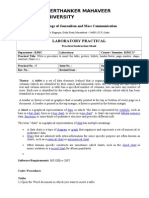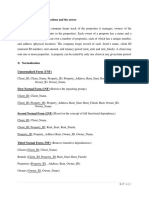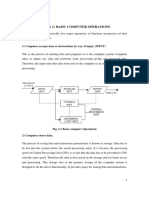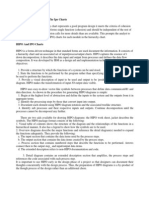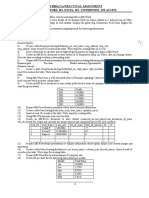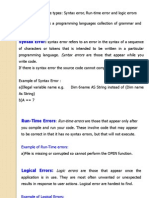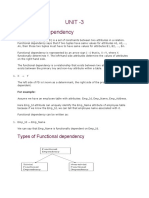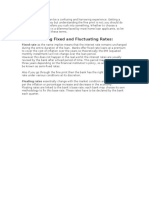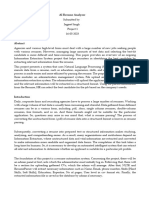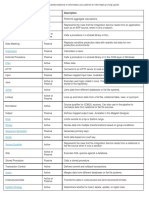Normalization and its Types
NORMALIZATION:
Normalization is the process of organizing data into a related table; it also eliminates
redundancy and increases the integrity which improves performance of the query. To
normalize a database, we divide the database into tables and establish relationships
between the tables.
Database normalization can essentially be defined as the practice of optimizing table
structures. Optimization is accomplished as a result of a thorough investigation of the
various pieces of data that will be stored within the database, in particular concentrating
upon how this data is interrelated.
Normalization Avoids:
Duplication of Data - The same data is listed in multiple lines of the database
Insert Anomaly - A record about an entity cannot be inserted into the table
without first inserting information about another entity - Cannot enter a customer
without a sales order
Delete Anomaly - A record cannot be deleted without deleting a record about a
related entity. Cannot delete a sales order without deleting all of the customer's
information.
Update Anomaly - Cannot update information without changing information in
many places. To update customer information, it must be updated for each sales
order the customer has placed
DE- NORMALIZATION:
Denormalization is the process of adding redundant data to speed up complex
queries involving multiple table JOINS. One might just go to a lower form of
Normalization to achieve Denormalization and better performance. Data is
included in one table from another in order to eliminate the second table which
reduces the number of JOINS in a query and thus achieves performance.
Normalization is a Six stage process - After the first stage, the data is said to be
in first normal form, after the second, it is in second normal form, after the
�third, it is in third normal form and so on.
First Normal Form (1st NF)
In 1st NF:
The table cells must be of single value.
Eliminate repeating groups in individual tables.
Create a separate table for each set of related data.
Identify each set of related data with a primary key.
Definition: An entity is in the first normal form if it contains no repeating
groups. In relational terms, a table is in the first normal form if it contains no
repeating columns. Repeating columns make your data less flexible, waste disk
space, and make it more difficult to search for data.
IMP: In 1NF relation the order of tuples (rows) and attributes (columns) does
not matter.
Example:
Orde
r
Customer
Contact Person
Total
Rishabh
Manish
134.23
Preeti
Rohan
521.24
Rishabh
Manish
1042.42
Rishabh
Manish
928.53
�The above relation satisfies the properties of a relation and is said to be in first
normal form (or 1NF). Conceptually it is convenient to have all the information in
one relation since it is then likely to be easier to query the database.
Second Normal Form (2nd NF)
In 2nd NF:
Remove Partial Dependencies.
Functional Dependency: The value of one attribute in a table is determined
entirely by the value of another.
Partial Dependency: A type of functional dependency where an attribute is
functionally dependent on only part of the primary key (primary key must be a
composite key).
Create separate table with the functionally dependent data and the part of the
key on which it depends. Tables created at this step will usually contain
descriptions of resources.
Definition: A relation is in 2NF if it is in 1NF and every non-key attribute is fully
dependent on each candidate key of the relation.
Example:
The following relation is not in Second Normal Form:
Orde
r
Customer
Contact Person
Total
Rishabh
Manish
134.23
Preeti
Rohan
521.24
Rishabh
Manish
1042.42
Rishabh
Manish
928.53
In the table above, the order number serves as the primary key. Notice that the
customer and total amount are dependent upon the order number -- this data is
�specific to each order. However, the contact person is dependent upon the
customer. An alternative way to accomplish this would be to create two tables:
Customer
Contact
Person
Rishabh
Manish
Preeti
Rohan
Orde
r
Customer
Total
Rishabh
134.23
Preeti
521.24
Rishabh
1042.42
Rishabh
928.53
The creation of two separate tables eliminates the dependency problem. In the
first table, contact person is dependent upon the primary key -- customer name.
The second table only includes the information unique to each order. Someone
interested in the contact person for each order could obtain this information by
performing a Join Operation.
Third Normal Form (3rd NF)
In 3rd NF:
Remove transitive dependencies.
Transitive Dependency A type of functional dependency where an attribute is
functionally dependent on an attribute other than the primary key. Thus its value
is only indirectly determined by the primary key.
Create a separate table containing the attribute and the fields that are
functionally dependent on it. Tables created at this step will usually contain
descriptions of either resources or agents. Keep a copy of the key attribute in the
original file.
A relation is in third normal form, if it is in 2NF and every non-key attribute of
the relation is non-transitively dependent on each candidate key of the relation.
Non-transitive dependency:
Let A, B and C be three attributes of a relation R such that A B and B C. From
these FDs, we may derive A C. This dependence A C is transitive.
Example:
Company
City
Stat
e
ZIP
ABC Ltd.
Mumbai
MH
1016
9
XYZ Ltd.
Noida
UP
3319
6
ASD Ltd.
Chennai
TN
2104
6
The above table is not in the 3NF.
In this example, the city and state are dependent upon the ZIP code. To place
this table in 3NF, two separate tables would be created -- one containing the
company name and ZIP code and the other containing city, state, ZIP code
pairings.
Company
ZIP
ABC Ltd.
10169
XYZ Ltd.
33196
ASD Ltd.
21046
�City
State
ZIP
Mumbai
MH
10169
Noida
UP
33196
Chennai
TN
21046
This may seem overly complex for daily applications and indeed it may be.
Database designers should always keep in mind the tradeoffs between higher
level normal forms and the resource issues that complexity creates.
Boyce-Codd Normal Form (BCNF)
In BCNF:
When a relation has more than one candidate key, anomalies may result even
though the relation is in 3NF.
3NF does not deal satisfactorily with the case of a relation with overlapping
candidate keys
i.e. composite candidate keys with at least one attribute in common.
BCNF is based on the concept of a determinant.
A determinant is any attribute (simple or composite) on which some other
attribute is fully functionally dependent.
A relation is in BCNF is, and only if, every determinant is a candidate key.
Definition: A relation is in Boyce-Codd Normal Form (BCNF) if every
determinant is a candidate key. (See the links in the box at right for definitions
of determinant and candidate key.)
The difference between 3NF and BCNF is that for a functional dependency A
B, 3NF allows this dependency in a relation if B is a primary-key attribute and A
is not a candidate key,
Whereas BCNF insists that for this dependency to remain in a relation, A must be
a candidate key.
�Example:
CLIENT INTERVIEW:
ClientNo
InterviewDate
InterviewTime
StaffNo
RoomNo
CR76
13-may-11
10:30
SG5
G101
CR76
13-may-11
12:00
SG5
G101
CR74
13-may-11
12:00
SG37
G102
CR56
02-july-11
10:30
SG5
G102
FD1
Key)
FD2
FD3
key)
FD4
ClientNo, InterviewDate -> InterviewTime, StaffNo, RoomNo (Primary
StaffNo, InterviewDate, InterviewTime -> ClientNo (Candidate key)
RoomNo, InterviewDate, InterviewTime -> ClientNo, StaffNo (Candidate
StaffNo, InterviewDate -> RoomNo (not a candidate key)
As a consequece the ClientInterview relation may suffer from update anomalies.
To transform the ClientInterview relation to BCNF, we must remove the violating
functional dependency by creating two new relations called Interview and
StaffRoom as shown below,
Interview (ClientNo, InterviewDate, InterviewTime, StaffNo)
StaffRoom (StaffNo, InterviewDate, RoomNo)
INTERVIEW
ClientNo
InterviewDate
InterviewTime
StaffNo
CR76
13-may-11
10:30
SG5
CR76
13-may-11
12:00
SG5
�CR74
13-may-11
12:00
SG37
CR56
02-july-11
10:30
SG5
STAFFROOM
StaffNo
InterviewDate
RoomNo
SG5
13-may-11
G101
SG37
13-may-11
G102
SG5
02-july-11
G102
BCNF Interview and StaffRoom relations.
An entity is in Fourth Normal Form (4NF) when it meets the requirement of
being in Third Normal Form (3NF) and additionally:
Has no multiple sets of multi-valued dependencies. In other words, 4NF states
that no entity can have more than a single one-to-many relationship within an
entity if the one-to-many attributes are independent of each other.
Many:many relationships are resolved independently.
Fourth Normal Form (4th NF)
In 4th NF:
An entity is in Fourth Normal Form (4NF) when it meets the requirement of
being in Third Normal Form (3NF) and additionally:
Has no multiple sets of multi-valued dependencies. In other words, 4NF states
that no entity can have more than a single one-to-many relationship within an
entity if the one-to-many attributes are independent of each other.
Fourth Normal Form applies to situations involving many-to-many relationships.
�In relational databases, many-to-many relationships are expressed through
cross-reference tables.
Definition: A table is in fourth normal form (4NF) if and only if it is in BCNF and
contains no more than one multi-valued dependency.
Example:
Take an example of Employee Table
info(Employee, Skills, Hobbies)
Employee
Skills
Hobbies
Programming
Golf
Programming
Bowling
Analysis
Golf
Analysis
Bowling
Analysis
Golf
Analysis
Gardening
Management
Golf
Management
Gardening
This table is difficult to maintain since adding a new hobby requires multiple new
rows corresponding to each skill. This problem is created by the pair of multivalued dependencies EMPLOYEE -> SKILLS and EMPLOYEE -> HOBBIES. A much
better alternative would be to decompose INFO into two relations:
Employee
Skills
Programming
Analysis
Analysis
Management
Hobbies(Employee, Hobby)
Employee
Hobbies
Golf
Bowling
Golf
Gardening
Fifth Normal Form (5th NF)
In 5th NF:
A relation that has a join dependency cannot be decomposed by a projection into
other relations without spurious results
A relation is in 5NF when its information content cannot be reconstructed from
several smaller relations i.e. from relations having fewer attributes than the
original relation
Definition: A table is in fifth normal form (5NF) or Project-Join Normal Form
(PJNF) if it is in 4NF and it cannot have a lossless decomposition into any
number of smaller tables.
Fifth normal form, also known as join-projection normal form (JPNF), states that
no non-trivial join dependencies exist. 5NF states that any fact should be able to
be reconstructed without any anomalous results in any case, regardless of the
number of tables being joined. A 5NF table should have only candidate keys and
it's primary key should consist of only a single column.
�Example:
Take an example of a buying table. This is used to track buyers, what they buy,
and from whom they buy. Take the following sample data:
Buyer
Vendor
Item
Shalley
Kashmir House
Jeans
Mary
Kashmir House
Jeans
Shalley
Radhika Sarees
Saree
Mary
Radhika Sarees
Saree
Shalley
Radhika Sarees
Suit
The problem with the above table structure is that if Claiborne starts to sell
Jeans then how many records must you create to record this fact? The problem
is there are pair wise cyclical dependencies in the primary key. That is, in order
to determine the item you must know the buyer and vendor, and to determine
the vendor you must know the buyer and the item, and finally to know the buyer
you must know the vendor and the item.
And the solution is to break this one table into three tables; Buyer-Vendor,
Buyer-Item, and Vendor-Item. So following tables are in the 5NF.
BUYER-VENDOR
Buyer
Vendor
Shalley
Kashmir House
Mary
Kashmir House
Shalley
Radhika Sarees
Mary
Radhika Sarees
�BUYER-ITEM
Buyer
Item
Shalley
Jeans
Mary
Jeans
Shalley
Saree
Mary
Saree
Shalley
Suit
VENDOR- ITEM
Vendor
Item
Kashmir House
Jeans
Radhika Sarees
Saree
Radhika Sarees
Suit













